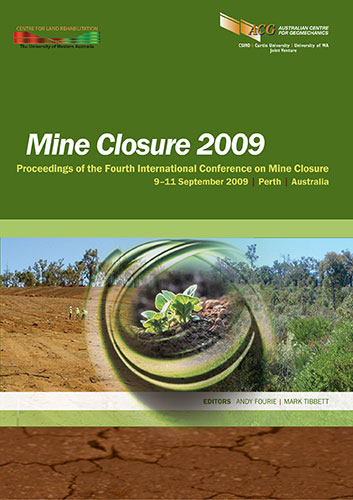From an open uranium mining pit to a new landscape architecture — a rehabilitation story of success

|
Authors: Schwarz, R; Grießl, D; Morgenstern, S Paper is not available for download Contact Us |
DOI https://doi.org/10.36487/ACG_repo/908_46
Cite As:
Schwarz, R, Grießl, D & Morgenstern, S 2009, 'From an open uranium mining pit to a new landscape architecture — a rehabilitation story of success', in AB Fourie & M Tibbett (eds), Mine Closure 2009: Proceedings of the Fourth International Conference on Mine Closure, Australian Centre for Geomechanics, Perth, pp. 581-592, https://doi.org/10.36487/ACG_repo/908_46
Abstract:
The paper reports the story of successful rehabilitation of one of the world’s largest open uranium pits after mine closure in 1977 and its course to “Neue Landschaft Ronneburg – New Landscape Ronneburg” in which it was given back to the public within the initiative “Bundesgartenschau – Exhibition Federal Garden Show” in 2007. The authors drew on the experience G.U.B. Ingenieur AG gained during the rehabilitation process, including pivotal expertise in services such as planning, construction supervision and project management. The uranium open pit “Lichtenberg” was operated between 1958 and 1976 and covered an area of approximately 160 ha. With a pit depth of 240 m and open pit volume of 160 million m3 it was one of the world’s largest open uranium pits. It was part of an extensive mining region of the former German Democratic Republic, which occasionally produced more than 10% of the world’s total uranium production. The owner, Wismut mining company, was the world’s number three uranium producer. When uranium mining was discontinued and the operations associated with mining shut down, rehabilitation of the post-mining landscape began. These rehabilitation measures were focussed on restoring the environment to an ecologically vital condition and establishing conditions favourable for regional economic revitalisation. Technical rehabilitation processes started in 1994, with the overall vision of converting the mining-degraded surface lands into public assets through a completely new holistic approach to reconstruction and management. The challenges faced included: the absolute requirement for rehabilitation of the abandoned open pits and rock and waste dumps as part of mine closure operations; prevention of acid rock drainage (ARD) from abandoned uranium mine sites; and the requirement for socio-economic redevelopment of the regions influenced by mining operations. These challenges not only included technical questions but also huge social and economic tasks which had to be tackled, especially in a densely populated area with 200,000 inhabitants. The approach to rehabilitation included development of a vision for closure and implementation of management plans for the multi-functional re-use of mine sites. From a technical perspective this comprised of multi-barrier systems and site-specific solutions to deal with, for example, the geological, hydrological, geotechnical and climatic conditions within the open pit. The main characteristics of the project were the intensive mass movements that had occurred, the average number of employees (up to 12,000 over 15 years) and the costs of 600 million EUR available for rehabilitation of the open pit. By the time that rehabilitation was completed the open pit was backfilled, shaped and reconstructed. This was the basis for landscape development. The works were completed in 2007, and on April 1st the newly developed park-landscape “Neue Landschaft Ronneburg – New Landscape Ronneburg” was given back to the public as part of the Federal Garden Show Exhibition, which marked the highlight of the long development process from a heavily impacted mining region to an ambitious and prosperous region in the heart of Europe. From an open uranium mining pit to a new landscape architecture — a rehabilitation story of success R. Schwarz et al. 582 Mine Closure 2009, Perth, Australia
References:
Bau-und Raumordnungsgesetz (BauROG) (1998) vom 18 August 1997 (BGBl. I S. 2081, 2102).
Grießl, D., Tynior, R. and Schwarz, R. (2008) Multi-Barrier Systems for Rock Dump Rehabilitation with Special Focus
on Hazardous Waste, Acid Rock Drainage and Radiation Protection, In Proceedings of the First International
Seminar on the Management of Rock Dumps, Stockpiles and Heap Leach Pads, Rock Dumps 2008, A.B. Fourie
(ed), 5–6 March 2008, Perth, Australia, Australian Centre for Geomechanics, Perth, pp. 233–250.
KrW-/AbfG (1994) Gesetz zur Förderung der Kreislaufwirtschaft und Sicherung der umweltverträglichen Beseitigung
von Abfällen (Kreislaufwirtschafts- und Abfallgesetz - KrW-/AbfG), “Kreislaufwirtschafts- und Abfallgesetz,
vom 27 September 1994 (BGBl. I S. 2705).
Seelemann, G. and Seelemann D. (2007) Neue Landschaft Ronneburg, Leipzig 2007.
From an open uranium mining pit to a new landscape architecture — a rehabilitation story of success R. Schwarz et al.
592 Mine Closure 2009, Perth, Australia
TA Abfall (1991) TA Abfall 2. AVwV Zweite allgemeine Verwaltungsvorschrift zum Abfallgesetz, Teil 1: Technische
Anleitung zur Lagerung, chemisch/physikalischen, biologischen Behandlung, Verbrennung und Ablagerung von
besonders überwachungsbedürftigen Abfällen, vom 12 März 1991 (GMBl. Nr. 8 S. 139).
© Copyright 2025, Australian Centre for Geomechanics (ACG), The University of Western Australia. All rights reserved.
View copyright/legal information
Please direct any queries or error reports to repository-acg@uwa.edu.au
View copyright/legal information
Please direct any queries or error reports to repository-acg@uwa.edu.au